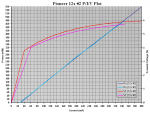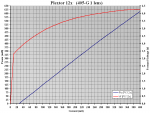IgorT
0
- Joined
- Oct 24, 2007
- Messages
- 4,177
- Points
- 0
..the high forwardvoltage could be a problem soon.. once we find out they are good for obscene outputs, and the (current?) flexdrive is not able to put out that high current at those voltages..
Luckily the apparent high forward voltage came from an error in my measuring setup.
As i have shown with the first two 12x's, their Vf's are LOWER than with 8x's at the same currents, NOT higher!
The reason it came to this error is the way i tested the diode. I only have two wires coming out of my Diode Analyzer... The device then measures the current THROUGH them and the voltage ACROSS them.
But it measures the voltage inside the device.
And since it measures at the end of wires where current flows through, and all wires have a certain small resistance, a small but noticable voltage dropp is introduced, directly proportionate to the current flowing through.
I could have avoided this problem by using four wires going to the diode connector. Two for the current and two separate ones, through which no current would flow, to measure the voltage across the diode directly (the closer the better)..
But since i didn't want a mess of wires (avoiding it was one of the reason i built the Diode Analyzer), i only used two, and then "measured" their resistance by shorting the diode connector end, passing current through the wires, reading off the measured voltage drop, and using Ohm's law to calculate their resistance.
A simple formula then removes this additional voltage drop from the measured voltage, and i am left with the diode Vf alone....
However in this case i made a mistake and introduced additional resistance into the setup. And my usual calculation only accounts for the known resistance of the two wires coming out of the Diode Analyzer, so i didn't notice the mistake until after i was done testing and compared the numbers to others...
Just a few minutes ago i also plotted the Vf into the plot i used to show the 12x's are different from 8x's, and it was WAY off (as well as climbed too fast)!
It was definitelly a measurement error, and i will have to repeat the test.
I am sure that after i re-plot it properly, it will come out low in comparison to 8x's, just like the first two...
These diodes are made to operate at a certain voltage, and higher power diodes are supposed to operate at the "same" voltage, even tho they need more current.
This means that at the same current, the Vf of higher power diodes HAS to be lower than that of lower power diodes (on average)...
Until now it was a rule, that higher power diodes had higher Ith's. But the 12x's displayed the exact opposite.. This really confused me, when i was trying to figure out if they are new diodes, until i realized the above about the Vf.
When it comes to Vf's, i am pretty sure, that other than variations due to standard manufacturing tolerances, the Vf's of these diodes will stay around 5.5V even tho we will drive each higher power diode with a higher current.
Last edited:





